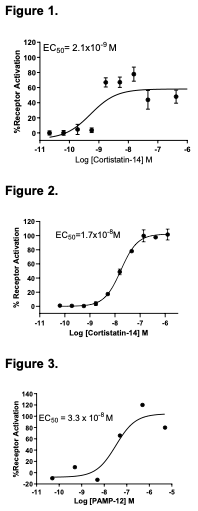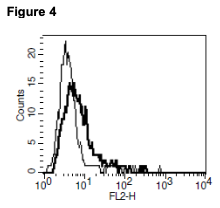Product Information
Catalog Number: CA1257aBA2
Lot Number: CA1257aBA2-082021
Quantity: 1 vial (2 x 106) frozen cells
Freeze Medium: CellBanker2 (Amsbio 11891)
Host cell: HEK293T β-Arrestin2
Transfection: Full-length human MRGX2 cDNA (GenBank Accession Number NM_054030) with FLAG tag sequence at N- terminus and ARRB2 cDNA (GenBank Accession Number NM_004313.3)
Recommended Storage: Liquid nitrogen upon receiving
Propagation Medium: DMEM, 10% FBS, 1 μg/mL puromycin, 50 μg/mL hygromycin
Stability: In progress
Data Sheet
Background: MRGX2 (MAS-related GPR member X2) is widely known as a receptor for cortistatin. It is probably involved in the function of nociceptive neurons and regulation of nociceptor function and/or development, including the sensation or modulation of pain. Cortistatin-14, a high potency agonist at the receptor, has biological functions including sleep regulation, locomotor activity and cortical function. Recent studies have found that MrgX2 is also a potential human PAMP-12 receptor that acts by inhibiting of the forskolin-elevated cAMP accumulation and regulates catecholamine secretion from adrenal glands.
Application: Functional assays


Figure 1. Dose-dependent stimulation from arrestin recruitment upon treatment with ligand, measured with MULTISCREENTM β-Arrestin Assay Kit (Multispan MSBA01). Figure 2. Dose-dependent stimulation of calcium flux upon treatment with ligand, measured with MULTISCREENTM Calcium 1.0 No Wash Assay Kit (Multispan MSCA01). Figure 3. Dose-dependent inhibition of forskolin-stimulated intracellular cAMP accumulation upon treatment with ligand, measured with MULTISCREENTM TR-FRET cAMP 1.0 No Wash Assay Kit (Multispan MSCM01). Figure 4. Receptor expression on cell surface measured by flow cytometry (FACS) using an anti-FLAG antibody. Thin line: parental cells; thick line: receptor-expressing cells.
References:
Robas et al. (2003) MrgX2 is a high potency cortistatin receptor expressed in dorsal root ganglion. J Biol Chem 278:44400-44404.
Kamohara et al. (2005) Identification of MrgX2 as a human G-protein-coupled receptor for proadrenomedullin N-terminal peptides. Biochem Biophys Res Commun 330:1146-1152.
